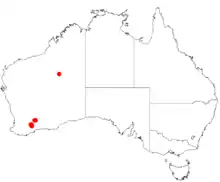Acacia lanuginophylla
Acacia lanuginophylla, or woolly wattle,[1] is a shrub of the genus Acacia and the subgenus Plurinerves that is endemic to south western Australia. It is currently listed as a vulnerable species according to the Environment Protection Biodiversity Conservation Act 1999.[1]
| Wooly wattle | |
|---|---|
 | |
| Scientific classification | |
| Kingdom: | Plantae |
| Clade: | Tracheophytes |
| Clade: | Angiosperms |
| Clade: | Eudicots |
| Clade: | Rosids |
| Order: | Fabales |
| Family: | Fabaceae |
| Subfamily: | Caesalpinioideae |
| Clade: | Mimosoid clade |
| Genus: | Acacia |
| Species: | A. lanuginophylla |
| Binomial name | |
| Acacia lanuginophylla | |
 | |
| Occurrence data from Australasian Virtual Herbarium | |
Description
The shrub typically grows to a height of 0.5 to 1.2 metres (2 to 4 ft)[2] and has a dense to erect, open, domed or spreading habit. The wooly branchlets have yellow-green new shoots. Like most species of Acacia it has phyllodes rather than true leaves, The densely wooly grey-green phyllodes have a narrowly elliptic to narrowly oblong-oblanceolate shape with a length of 1.5 to 4 cm (0.59 to 1.57 in) and a width of 3.5 to 10 mm (0.14 to 0.39 in) and have three main longitudinal nerves and with noticeable secondary nerves.[1] It blooms from July to October and produces yellow flowers.[2]
Taxonomy
The species was first formally described by the botanists Bruce Maslin and Richard Sumner Cowan in 1990 as part of the work Acacia Miscellany. Some oligoneurous species of Acacia (Leguminosae: Mimosoideae: Section Plurinerves) from Western Australia as published in the journal Nuytsia. It was reclassified as Racosperma lanuginophyllum by Leslie Pedley in 2003 then returned to genus Acacia in 2005.[3]
Distribution
It is native to an area in the Wheatbelt and Goldfields-Esperance regions of Western Australia where it is commonly situated along drainage lines or in flat areas growing in clay-sand, sandy or gravelly soils[2] as a part of open mallee over low scrub communities. There are only nine remaining populations or fifteen subpopulations of the plant remaining with an estimated 5,483 individuals remaining which are found in the Shire of Lake Grace and Shire of Yilgarn where over 75% of the native vegetation has been cleared.[1]
See also
References
- "National recovery plan for the Woolly Wattle (Acacia lanuginophylla)". Department of Agriculture, Water and the Environment. 2008. Retrieved 2 December 2020.
- "Acacia lanuginophylla". FloraBase. Western Australian Government Department of Biodiversity, Conservation and Attractions.
- "Acacia lanuginophylla R.S.Cowan & Maslin". Atlas of Living Australia. Global Biodiversity Information Facility. Retrieved 2 December 2020.
